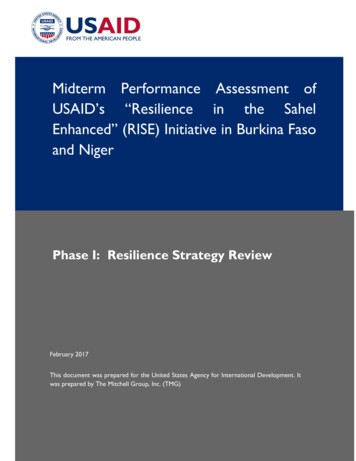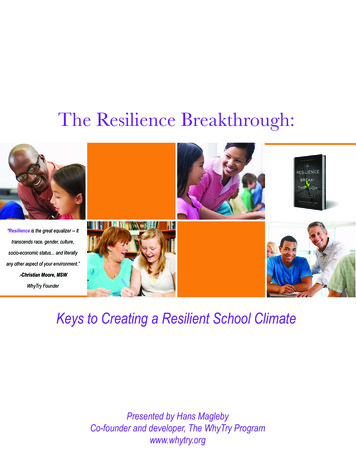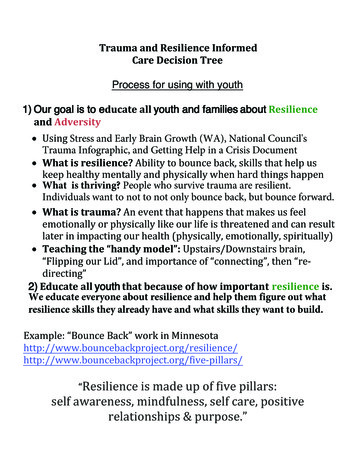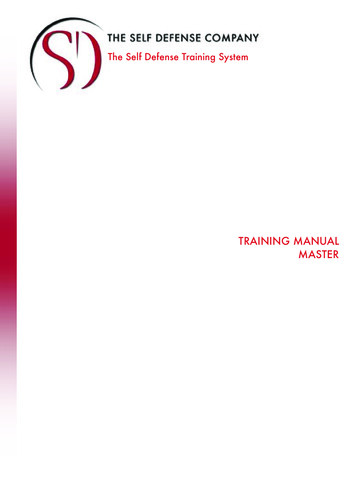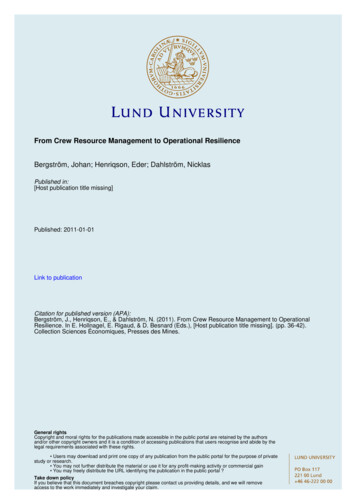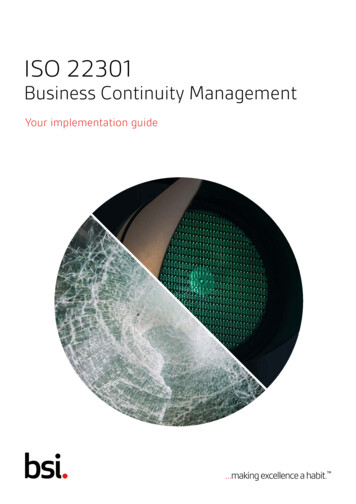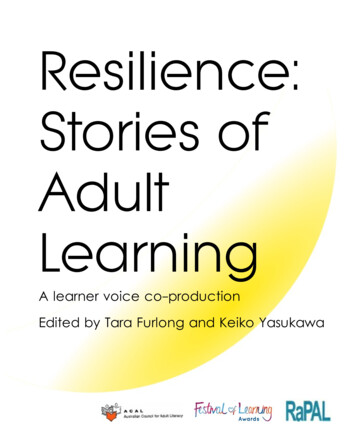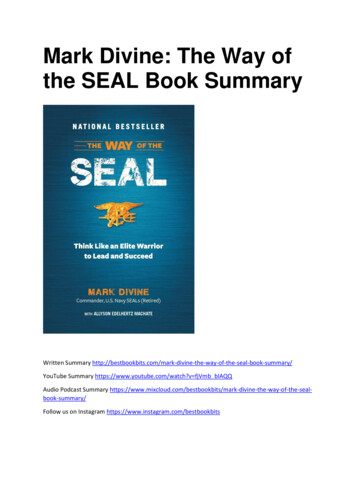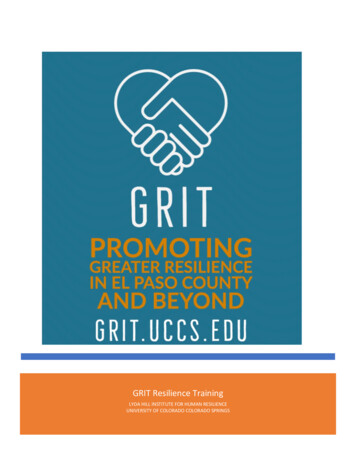
Transcription
GRIT Resilience TrainingLYDA HILL INSTITUTE FOR HUMAN RESILIENCEUNIVERSITY OF COLORADO COLORADO SPRINGS
Lyda Hill Institute for Human Resilience, University of Colorado Colorado SpringsGRIT Resilience Training Outline: Community TrainingPg 2: Module 1: GRIT Resilience Training Model and ConceptRole and Expectations of GRITCore Principles of Psychological First AidIntroduction to GRIT StepsPg. 13: Module 2: Self-Efficacyo Trauma Related Self-Efficacyo Collective Self-EfficacyResilienceStressors and Stress ReactionsGRIT Step 1: Making ContactPg. 24: Module 3: GRIT Step 2: Ask Questions about Feelings, Distress, and WellbeingGRIT Step 3: Identifying Coping Strengths and ResiliencePg. 29: Module 4: GRIT Step 4: Adding to StrengthsPg. 32: Module 5: GRIT ResourcesReferring to Mental HealthGRIT Step 5: Reviewing, Summarizing, Discussing Action Steps, Giving ResourcesSelf-CarePg. 40: AppendicesLyda Hill Institute for Human Resilience, University of Colorado Colorado SpringsFebruary 20211
Lyda Hill Institute for Human Resilience, University of Colorado Colorado Springs2GRIT Resilience TrainingWelcome to the GRIT Resilience Training. GRIT has been established to train volunteers in thecommunity to promote wellness and resilience among fellow community members – friends,family, and acquaintances – in the wake of the stress caused by COVID-19 (Coronavirus).Due to the impact of the stresses of COVID-19 on individuals, families, and communities, thecurrent pandemic can be viewed as a disaster for the community, the country, and the world.In times of disaster, strengthening coping, spreading support, and providing resources can havea positive impact on healing and resilience for everyone.With GRIT, you can help strengthen resilience and spread this support to peopleyou know in your community.Module 1: GRIT Resilience TrainingGRIT Resilience Training ModelGRIT was established by Dr. Charles Benight and his team at the UCCS Lyda Hill Institute forHuman Resilience to promote strength and empowerment.Your training will enable you to provide direct support to your loved ones, your neighbors, andfriends. Some of you will be in more professional roles (e.g., nurses, schoolteachers, physicaltherapists, etc.) where this approach might also be extremely helpful. In those cases, you canuse these skills with colleagues as well as clients/patients/students.Lyda Hill Institute for Human Resilience, University of Colorado Colorado SpringsFebruary 2021
Lyda Hill Institute for Human Resilience, University of Colorado Colorado Springs3We will most likely find a need for this type of support continuing past the time that we are allsheltering in place; thus, be prepared to be a resource for several months as things slowly moveback to normalcy.With GRIT Resilience Training, you will have skills that you can use in future major (or evenminor) events that may affect our community. Look for more trainings that we will offer in thefuture, as well as excellent trainings by other non-profit organizations such as the Red Cross(see ining).Self-Reflection: Why did you sign up to become a GRIT Resilience Training?Self-Reflection: What are you hoping to get out of the GRIT Resilience Training?What is a GRIT Resilience Support “Coach”?A GRIT Resilience Support Coach’s role is to support and motivate another personwho may be struggling with the COVID-19 pandemic (or other disaster). Thisrole is similar to other coaches you are already familiar with, such as a sportscoach or a life coach.In the sports world, when athletes struggle to improve a skill or hone theiroverall performance, they turn to a coach. In comparison, if theyare injured, they turn to a medical professional. A GRIT Coach acts in a similarspirit, embodying the qualities of a helpful coach. You are not asked or expectedto act as a team, wellness, or life coach. GRIT Resilience Support Coaches provideeducation and support at an individual, group, and community level and are notmedical or mental health professionals.Self-Reflection: What types of qualities make up a good coach?Lyda Hill Institute for Human Resilience, University of Colorado Colorado SpringsFebruary 2021
Lyda Hill Institute for Human Resilience, University of Colorado Colorado SpringsGRIT Coaches provide short-term resilience support through effective listening, offering socialsupport, strengthening individual coping strengths, and providing resources and referrals.Ultimately, they provide hope during a challenging time.GRIT never replace professional help!Who to HelpGRIT focus on helping friends and acquaintances local to them. They focus on identifyingindividuals and groups who might be especially in need of coping support during times ofdisaster, like the COVID-19 coronavirus pandemic. There is no clear list of individuals in need,and the GRIT community should use their own judgment and knowledge of their friends andacquaintances, to think about who to reach out to.However, it is important to consider the following indicators of possible need: Someone seems especially withdrawn from others and seems to be isolating morethan is necessary given the virus situation (e.g., not linking with anyone virtually) An individual is showing signs of stress such as appearing down, being unusuallyirritable, crying, or just seeming out of sorts A person is not sleeping or seems really exhausted Someone is working in a high stress/impact job (first responder, health care worker,small business owner An individual is already coping with an existing mental health problem, likedepression, PTSD, alcohol or drug use, or schizophrenia Someone who was already under significant stress (such as a chronic illness orfinancial difficulty) or going through a difficult life transition (such as job change,divorce, death in the family, etc.) Someone who is a single parent who is trying to manage having children at home andfigure out financial situation with the stay-at-home requirementSelf-Reflection: Who in your life could benefit from a GRIT conversation?Lyda Hill Institute for Human Resilience, University of Colorado Colorado SpringsFebruary 20214
Lyda Hill Institute for Human Resilience, University of Colorado Colorado Springs5Self-Reflection: What skills, talents, and abilities do you feel you have that make you anatural helper?The GRIT Resilience TrainingThis Training provides information on: General stress, disaster and trauma-related stress, and COVID-19 stress reactions Resilience, disaster recovery, and coping skills and support.It offers training in a brief conversational intervention that can be used with GRIT to supporteffective coping by friends, family members, neighbors, co-workers, and other acquaintances. Itis intended to function as one element within more comprehensive planning to help individualsand communities to be as resilient as they can be in the wake of the COVID-19 outbreak orother disasters.It provides a rich set of technology-based tools for you to refer people to in helping themmanage things, including: My Resilience Internet tool for managing COVID (and other disaster) stressRelaxation and mindfulness phone appsHealth & Fitness phone appsGoals of GRIT Resilience Training Gain a basic understanding of resilience, common stress reactions in disasters, andstress-related problems Learn how to support and listen to someone who may be struggling with the pandemicexperience or other disaster Understand how to help build strength and resilience within individuals and families,and throughout the community Learn how to promote effective coping skills, sense of self-efficacy (confidence in abilityto cope), and resilienceLyda Hill Institute for Human Resilience, University of Colorado Colorado SpringsFebruary 2021
Lyda Hill Institute for Human Resilience, University of Colorado Colorado Springs 6Learn when referral for formal mental health counseling might be needed, and how andwhere to referLearn about available community resources, and how to guide individuals to moreresources when needed.The GRIT Resilience ConceptSocial support is a major factor in effective coping and resilience to adversity. A helpingconversation is one good way of offering social support.Goals of the GRIT helping conversation include: Encouraging the person to talk about how they are coping with the stresses Drawing attention to and identifying what is working for them, their strengths Reviewing key activities that can make coping evenmore effective Sharing helpful community resources Sharing technology-based resources Encouraging active coping5 Steps to GRITThe 5 Steps provide a guide to conducting a supportive helping conversation to support others.You can use these 5 steps to guide and structure your helping conversations:1Make Contact2Ask Questions about Feelings, Distress, and Wellbeing3Identify Coping Strengths and Resilience4Add to Strengths5Review, Summarize, Discuss Action Steps, Give ResourcesLyda Hill Institute for Human Resilience, University of Colorado Colorado SpringsFebruary 2021
Lyda Hill Institute for Human Resilience, University of Colorado Colorado Springs7GRIT Roles and Expectations To undertake initial training To practice and master the skills of holding supportive conversationsTo maintain ethical behavior and keep confidence and privacy To be knowledgeable about resources in the community To actively encourage others to participate in education and awareness programsdirected toward physical and emotional fitness To abide by the spirit of GRIT and promote resiliency throughout the community.Ethics of GRITConfidentiality Effective connection and support often rely heavily on a sense of trust betweenindividuals in the conversation You may hear sensitive information from the speaker, or information the speaker wouldnot want shared Keep in mind that you may be contacting friends,family, colleagues, and people you know in yourcommunity The strength of these relationships can depend greatlyon you being able to keep the speaker’s confidenceand trust Do not share any personal information from your GRIT conversations with others Try to have conversations in private locations when possible, to avoid being overheard.Self-Reflection: Have you experienced a time when your trust was compromised? What didthat feel like?Lyda Hill Institute for Human Resilience, University of Colorado Colorado SpringsFebruary 2021
Lyda Hill Institute for Human Resilience, University of Colorado Colorado Springs8Range of SupportRemember that you will be acting as a “Coach”, and never as a mental health or medicalprofessional. GRIT is an additional source of coping support, along with more traditional formsof help such as mental health treatment.You may provide support, validate experiences, discuss coping, and share resources, but avoidgiving any counseling or medical advice.Knowledge of ResourcesWe will provide you with a set of resources that you can access and share. You will need tofamiliarize yourself with these resources so you can answer questions about them. Moregenerally, it will be important and helpful to be knowledgeable about local resources in yourcommunity. 211 is a great resource that can be accessed 24/7 and provides information about localresources and services Also, National Crisis Services at 1-844-493-TALK (8255) or text TALK to 38255 to speak toa trained professional is a wonderful resource and is available 24/7Self-Reflection: What types of resources are available in your own community? Do you knowhow to access them?Practice of SkillsTake time to practice the skills you learn in this program!Sit down with a family member or friend (remember you can connect virtually!) to practice thequestions and conversations you may have with others. It’s also helpful to practice the copingskills yourself (it will make you more resilient!!), that you will discuss with friends and family, soyou can share your own experiences with others. Try out the various resources yourself(especially online systems), in order to benefit from them. This will help you talk with friendsand family about the resources.Lyda Hill Institute for Human Resilience, University of Colorado Colorado SpringsFebruary 2021
Lyda Hill Institute for Human Resilience, University of Colorado Colorado Springs9Self-Reflection: When practicing these skills, who will you be able to practice with? Will it bein-person or over technology?ReportingAfter your GRIT training is complete, you will be sent a survey weekly through email. The surveywill inquire about the number and type of contacts you had in the week, as well as thefollowing questions: What were your successes with GRIT this week? What were your main concerns with GRIT this week? What areas of strength and positive functioning and well-being did you discuss? Howuseful were these areas of focus? If you provided a referral or resource, what type of referral did you provide? How oftendid you provide these referrals? How confident did you feel in utilizing the skills you learned in the GRIT ResilienceTraining? Did you find that GRIT helped in your own coping this week? How stressful was it for you to be a GRIT coach this week? Have you recommended GRIT Resilience Training to others? Do you have any questions regarding GRIT?This information will assist us in evaluating the success and trends of the GRIT ResilienceTraining.Core Principles of Psychological First AidIn this training you will learn about making contact and holding a conversation to promotestrength, resilience, and effective coping. Our approach is based on core principles ofPsychological First Aid. As you talk to friends, family, and acquaintances, and follow the 5 Stepsof GRIT helping conversations, be thinking about promoting the following in the individuals youare supporting:Lyda Hill Institute for Human Resilience, University of Colorado Colorado SpringsFebruary 2021
Lyda Hill Institute for Human Resilience, University of Colorado Colorado Springs10Personal sense of safetyPhysical and mental calmingConnectedness with other peopleHope for the futureSense of self- and collective efficacy, confidence in ability to cope effectively with the disasterPromote a Sense of SafetyDisasters, including COVID-19, threaten the lives and livelihood of individualsand communities. As the numbers continue to rise throughout the world, sotoo is the sense of personal threat and vulnerability. This is especially truefor individuals who may have underlying health conditions, are immunecompromised, are 60 years or older, have been around those confirmed asinfected, and those who have loved ones that match those descriptions aswell.The pandemic has also severely affected the employment of millions of people, whether thatbe lost work hours or total job loss. These factors can combine to a threatened sense ofpersonal and financial safety.An additional complication with COVID-19 is the lingering unknown. Individuals do not knowwhen the infection rate will reach its peak, nor when that rate will slow and eventually fall.Stress reactions tend to persist when the sense of threat or danger continues and is ambiguousor unpredictable.Individuals will feel safer if they know how to practice personal safety behaviors (e.g., socialdistancing), get social support from others, find and use helpful resources, feel themselves tobe coping effectively, and experience positive emotions.Check out the Northeastern University COVID-19 Safety Module for be-safe-and-resilient/Self-Reflection: What are some ways you are practicing safety in your own home?Lyda Hill Institute for Human Resilience, University of Colorado Colorado SpringsFebruary 2021
Lyda Hill Institute for Human Resilience, University of Colorado Colorado Springs11Promote CalmingStress may increase physical tension as well as increasing anxiety and emotional distress, sohaving a heightened state of awareness and tension is normal during the pandemic or in theimmediate aftermath of a conventional disaster. It is helpful for those experiencing tension tocalm themselves physically and mentally. Calming techniques can be used to ease the effect ofstress and anxiety.With GRIT, you can discuss ways that individuals can calm themselves,especially by sharing apps or other resources that can help withcalming. These apps include Calm, Headspace, and Happify.Being able to calm yourself is an important component of resilience!Self-Reflection: What are some ways you calm or relax yourself now?Calming via Normalization of ExperienceIt is important for us all to recognize that initial strong emotional responses during andimmediately following a traumatic event or disaster are common and are not usuallyconsidered a sign of a serious mental health problem. With support, access to resources, andthe passage of time, most people will return to a sense of normalcy once the event has passed.Indeed, this is the major focus of the GRIT Program: to provide resilience support to those inneed. Some people may be hard on themselves and interpret their stress reaction as a negativereflection on themselves (“I’m crazy”, “I’m weak”, “I shouldn’t feel thisway”, “I’m better than this”, etc.). Such thoughts can lead to orworsen anxiety and distress.Remind others that they are going through a stressful timeand that it is common and expected to feel distress.ConnectednessSocial support has been shown to be related to better emotionalwellbeing and recovery following trauma and disaster. Socialconnections also help in communication, information-sharing,problem-solving, and attaining resources after a disaster.Lyda Hill Institute for Human Resilience, University of Colorado Colorado SpringsFebruary 2021
Lyda Hill Institute for Human Resilience, University of Colorado Colorado Springs12It is therefore important to maintain or develop levels of social connectednessduring a pandemic or following a disaster.During the pandemic when we may be advised not to connect face-to-face, we can use ourtechnologies to keep our social connectedness!Self-Reflection: What are ways you have stayed connected in the past several months?Promote HopeHope is believing the future will be better and things will work out.Hope can seem like a small thing, but studies show those who maintainoptimism in times of stress are more likely to have positive outcomes!After trauma, a sense of hopelessness may set in for many people. Thegood news is that as a whole, humans are resilient, and time and timeagain come together as a community to rebuild, re-engage, and pushforward from disasters. We will, and are, doing this with the pandemic.Promote Sense of Self- and Collective EfficacySelf-efficacy centers around an individual’s belief in their ability tohandle the stress and threats that the disaster (pandemic) is causing.A strong sense of coping self-efficacy provides a person with a sense ofcontrol over the situation, which is fundamental to resilience.Individual self-efficacy is developed through:1Effectively handling difficult challenges (i.e., mastery)2Seeing others, like a friend or family member, effectively handling stressors3Receiving support from a friend or love one who encourages “you can dothis!”4Effectively managing one’s physical or emotional distressLyda Hill Institute for Human Resilience, University of Colorado Colorado SpringsFebruary 2021
Lyda Hill Institute for Human Resilience, University of Colorado Colorado Springs13Module 2: Self-Efficacy, Stress, and MakingContactExplain your roleGoals for this Module Learn about disaster and traumatic stressLearn about COVID-19-specific stressorsLearn about developing self-efficacy and resilienceStart GRIT steps!: Making Contact and Asking QuestionsStressorsA stressor is any event or condition that causes a person to adapt or change insignificant ways.In response to the event, stressors have many sources and include any situation in life requiringa significant change or adaptation. We can have a stress response to an actual acute challenge,or to perceived or imagined (i.e., psychological) threats.As humans, we can stress about events or situations that have not yet happened or aboutsomething that is not even true. The physiological and emotional response to thesepsychological threats is similar to an actual physical threat.Stress ReactionsStress reactions are the mind and body’s reactions to an unusual demand such as a threat orchallengeWhether this demand is real or imagined, outside the body or within, the body will respond in acharacteristic way known as the Stress Response.When the brain interprets something as a stressor, it sends alarm signals via nerves andhormones to prepare the body to “fight, flight, or freeze.” Consequently, senses become morealert; muscles tighten and tense for action, heart and breathing rates increase so that moreblood is provided for vital organs.When stress is chronic, these physical affects can cause or worsen a range of health problems,including hypertension, autoimmune problems, chronic body aches and pains, menstrualproblems, indigestion or stomach upset, headaches, insomnia, and frequent illnesses.Lyda Hill Institute for Human Resilience, University of Colorado Colorado SpringsFebruary 2021
Lyda Hill Institute for Human Resilience, University of Colorado Colorado Springs14Stress can change many aspects of our thinking, emotions, and actions:CognitivePoor concentration, forgetfulness, difficulty making decisionsEmotionalAnxiety, grief, irritability, anger, nervousness, withdrawal, depression,feeling overwhelmedBehavioralChanges in eating habits, increased smoking, greater consumption ofalcohol or prescribed and/or illicit drugs, increased accident proneness,and changes in sexual libidoDisaster and Traumatic StressSome stressful events are considered traumatic in intensity. These are typically events thatthreaten the life, health, or safety of an individual, either directly or indirectly. Traumatic eventscan include natural and human-caused disasters, physical and sexualassaults, war, child abuse, and life-threatening illness. Distress andsymptoms following exposure to such an extreme event may be moresevere or persistent than general stress reactions.Disasters are events that challenge individual capacity for adaptation,which can lead to the onset of a range of mental health outcomes,from minimal and manageable to severe psychological distress and/orimpairment that may last for weeks or years after the event.Self-Reflection: What are other examples of disasters your community has experienced inthe past 10 years?Lyda Hill Institute for Human Resilience, University of Colorado Colorado SpringsFebruary 2021
Lyda Hill Institute for Human Resilience, University of Colorado Colorado Springs15Coronavirus vs. Conventional DisastersBoth kinds of disaster can produce: Threat to the safety and wellbeing of oneself and loved onesLoss of community Loss of access to normal activities of daily lifeUnlike most natural disasters, the pandemic creates a sense of ongoing threat.In conventional disasters, help is usually offered “post-disaster.” With COVID-19, help must beoffered while the disaster is still ongoing. Ongoing threat can create a sense of continuingdread that can pervade the community of those exposed.The coronavirus is affecting everyone, unlike most disasters that are confined to specific areas.There are no safe zones during the pandemic, except at home alone. In the pandemic, healthcare workers are especially affected, and there is an important need to mobilize supportservices for them.Because of the risk of infection and need for social distancing, face-to-face disaster responseservices and face-to-face mental health counseling are largely not available (PFA, counseling) ina pandemic. The physical isolation required by coronavirus interferes with social connectionsand support, which are important coping tools.Self-Reflection: Have there been times in the past several months when you have struggledwith the social isolation?The unfamiliar and invisible nature of the virus threat makes it more difficult to cope with. Thedestruction and dramatic impact of a natural disasters are usually very clear, such as when anearthquake or fire claims lives and property in an acute phase, after which the majority of theshock is finished. By contrast, the traumatic aspect of technological disasters may be less acuteand involve learning of, versus witnessing of an event, with this happening over an extendedtime period, often with substantial delays.Frightening information is received in doses, in fragments and contradictory ways. In thepandemic, there is overwhelming media coverage that can increase anxiety rather than reduceit. With the virus, people worry about different things (e.g., fears of having symptoms, healthanxiety) than in natural disasters.Lyda Hill Institute for Human Resilience, University of Colorado Colorado SpringsFebruary 2021
Lyda Hill Institute for Human Resilience, University of Colorado Colorado Springs16Self-Reflection: Have you found news coverage of the COVID-19 outbreak helpful orharmful? In what ways?Virus-Specific StressorsThere are a number of kinds of experience in the pandemic that can be especially stressful forthose unfortunate enough to have them.For those who have become infected: Feeling afraid of dying Anxiety about passing the infection to their families Separation from family and need to social distance from them Children worried about sick parents Exposure to ethnic stigma (e.g., hostility to Chinese-Americans)For those in specific situations: Witnessing and caring for individuals who are severely ill Loss of a loved one or friendMany people will experience cascades of losses and psychological stress above and beyond thefear-provoking consequences of the disease itself: Financial stress (food and resource insecurity) Loss or interruption of employment and structured activity Loss of access to pleasurable activities Loss of access to social contactsActions needed to stay safe - social distancing – can increase stressby reducing access to normal routines, enjoyable activities, and social supports.Lyda Hill Institute for Human Resilience, University of Colorado Colorado SpringsFebruary 2021
Lyda Hill Institute for Human Resilience, University of Colorado Colorado Springs17Stresses of Health Care Work during COVID-19Some health care personnel have often experienced especially great levels of stress, due to thefollowing kinds of experiences that might be troubling them: Physical and mental exhaustionTorment of making difficult decisions about who will receivecarePain of losing patients and colleaguesInfection risk of catching a disease with a potentially lethaloutcome (perceived life threat)Separation from family and need to social distance fromthemAnxiety about passing the infection to their familiesLimited access to personal protective equipment (PPE) and needed suppliesWhen becoming infected, sudden role reversal from a care provider to a patient maycreate great adjustment challenges, frustration, and feelings of helplessnessDeveloping Self-EfficacyThink about Marathon runners. Marathoners did not put on their shoes the first day of trainingand run 26.2 miles!They started with what they could accomplish that day. Maybe it was three miles, maybe one,or maybe it was a walk around the block. Then when the three miles/one mile/walk feltachievable, the distance was increased, bit by bit, until the runner could run 26.2 miles(mastery experience)!In learning how to run a marathon, the runner also learned how to breathe effectively andregulate emotions.Then, when they run the race, they run with others who are alsodemonstrating the ability to run a marathon (vicarious experience) andthere are people on the sidelines cheering them on (social persuasion).Finally, the runner takes into account their own physical and emotionalstate: do they have achy knees, pre-run jitters?Taking all of this is account, the runner runs a marathon!For the COVID-19 crisis, you can also see how having a strong sense of coping self-efficacywould be helpful in being resilient. Just like the marathoner, setting achievable goals in yourdaily life reinforces a sense of mastery as you accomplish them.Lyda Hill Institute for Human Resilience, University of Colorado Colorado SpringsFebruary 2021
Lyda Hill Institute for Human Resilience, University of Colorado Colorado Springs18These goals can be quite domestic such as “I set a goal today to walkaround the block. And I felt so much better after I did it!” Or, “I seta goal to help the kids with their homework after I finished my work.Being clear about the goal helped me to be more intentional withthem and made me feel really good when I accomplished this goal.”These types of experiences increase a person’s sense of personalcontrol which is fundamental to successful coping and resilience.Self-Reflection: Think of times in your life when you have overcome a challenge. What wasthat process like for you? What got you through it?Trauma-Related Self-EfficacyTrauma-related self-efficacy focuses on how an individual feels about their personal ability tocope and come through the trauma: To regulate their emotions during and following a traumatic experience To solve problems related to the disaster To maintain relationships and social networks To fulfill trauma-related tasks (e.g., possibly relocating, obtaining a new job, or restoringproperty)For many in the COVID-19 crisis, there may be specific stressors that people are having tomanage related to the virus. We want to encourage individuals to focus on what aspect ofthese stressors they have some control over and to focus on their ability to handle these.Some people are struggling more because they are focusing on what they cannot control (e.g.,whether the economy is really going to be
coach or a life coach. In the sports world, when athletes struggle to improve a skill or hone their overall performance, they turn to a coach. In comparison, if they are injured, they turn to a medical professional. A GRIT Coach acts in a similar spirit, embodying the qualities of a helpful coach. You are not asked or expected
